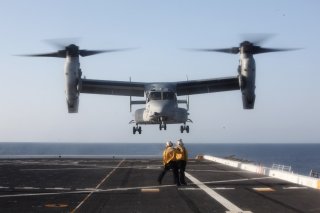The Navy is Ready to Deploy Its New CMV-22B Osprey Aircraft
The Navy’s new Osprey will provide maritime warfare commanders with a range of new tactical options.
The U.S. Navy is rolling out a new Osprey tiltrotor aircraft that is tailored to perform Navy-specific operations, including transporting marines, supplies, and weapons across unprecedented distances.
The Navy’s CMV-22B Osprey, which has been in development for several years, will take over the carrier onboard-delivery mission that is currently performed by the C-2 Greyhound. The Navy variant has hit speeds of up to 280 miles per hour in testing and is engineered with additional fuel capacity to support extended transport missions. These features increase the Osprey’s combat radius beyond what is currently possible.
“With 50 [percent] more internal fuel than the Marine Corps’ Osprey variant, CMV-22B can transport up to 6,000 pounds of cargo and personnel over a 1,150 nautical mile range,” a Navy report on the CMV-228 Osprey said. The report added that “the Navy redesigned the forward sponson fuel tanks and added two wing fuel tanks to add capacity and extend the flight range.”
Following a rigorous series of tests, the Navy aircraft has now reached initial operating capability (IOC) and is on track for formal production. The “IOC designation is more than a stamp of approval,” U.S. Marine Corps Col. Brian Taylor, V-22 Joint program manager, noted in the report. “It is a vote of confidence from top Navy leadership that the design, testing, and production of this aircraft meet the logistical needs of the carrier air wings designated to fly the CMV-22B.”
The Navy’s Osprey deployed on the USS Carl Vinson aircraft carrier last summer and has flown alongside carrier-launched F-35C stealth fighter jets. The Navy reports that Bell Boeing has delivered fourteen aircraft and has forty-four on contract, with full operational capability expected in 2023.
The Navy’s new Osprey will provide maritime warfare commanders with a range of new tactical options. As a tiltrotor, the Osprey can take off and land vertically, which means that personnel, weapons, and equipment transport operations will not be restricted to runways or landing strips. This will open up the possibility of “forward dropping” marines in support of an amphibious attack. By employing the Navy’s Mounted Vertical Maneuver concept, an Osprey will be able to lift and drop forces behind enemy lines to reinforce forward bases, conduct assault raids, or perform clandestine surveillance missions.
As the Osprey’s tiltrotor brings the speed of an airplane and the maneuverability of a helicopter, it offers a wider sphere of tactical options for picking up forces from land areas and returning them to carriers and amphibious assault ships. The range of the Osprey is also quite significant. Its unprecedented range aligns with the Navy’s Distributed Maritime Operations strategy, which calls for an increasingly disaggregated force to leverage long-range sensors and weapons in support of ocean warfare maneuvers.
Kris Osborn is the Defense Editor for the National Interest. Osborn previously served at the Pentagon as a Highly Qualified Expert with the Office of the Assistant Secretary of the Army—Acquisition, Logistics & Technology. Osborn has also worked as an anchor and on-air military specialist at national TV networks. He has appeared as a guest military expert on Fox News, MSNBC, The Military Channel, and The History Channel. He also has a Master's Degree in Comparative Literature from Columbia University.
Image: Reuters.

